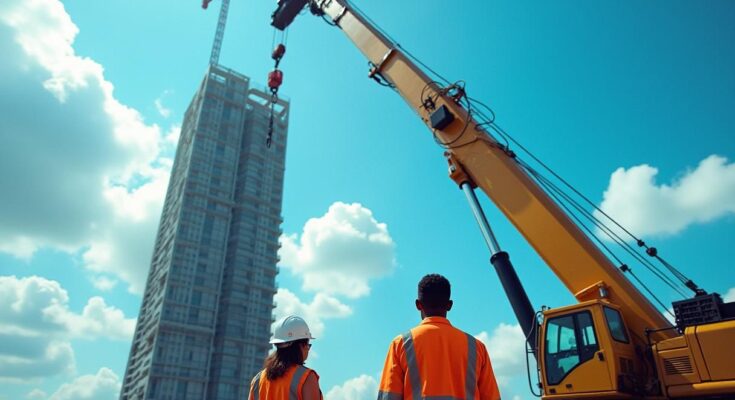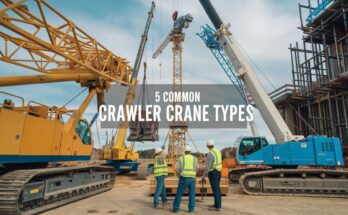Crawler cranes are powerful and versatile pieces of heavy equipment used in construction and industrial projects. Known for their stability and lifting capacity, these machines are essential for tasks that require moving heavy materials or equipment. But what exactly is a crawler crane, and how does it work? In this simple guide, we’ll break down everything you need to know about crawler cranes, including their features, uses, advantages, and more.
What is a Crawler Crane?
A crawler crane is a type of mobile crane mounted on a set of tracks, or “crawlers,” instead of wheels. These tracks provide stability and allow the crane to operate on uneven or soft terrain, making it ideal for construction sites, infrastructure projects, and industrial applications. Crawler cranes are equipped with a boom (arm) and a hook or lifting attachment, enabling them to lift and move heavy loads with precision.
Unlike traditional wheeled cranes, crawler cranes do not require outriggers for stability, as their wide track base distributes the weight evenly. This design allows them to handle heavier loads and operate in challenging environments.
Key Features of a Crawler Crane
- Tracks Instead of Wheels:
The crawler tracks provide excellent stability and mobility, especially on rough or unstable surfaces like mud, gravel, or sand. - High Lifting Capacity:
Crawler cranes are designed to lift extremely heavy loads, often ranging from 40 tons to over 3,000 tons, depending on the model. - Versatility:
They can be equipped with different types of booms (lattice or telescopic) and attachments, making them suitable for various tasks. - No Need for Outriggers:
The crawler tracks eliminate the need for outriggers, saving time during setup and allowing the crane to move while carrying a load. - Mobility on Job Sites:
Crawler cranes can move around a job site with ease, even while carrying heavy loads, thanks to their robust track system.
How Does a Crawler Crane Work?
Crawler cranes operate using a combination of mechanical, hydraulic, and electrical systems. Here’s a simplified breakdown of how they work:
- Setup:
The crane is transported to the job site in sections and assembled on-site. Once assembled, it is ready to move on its tracks. - Lifting Mechanism:
The crane’s boom is extended or adjusted to the required length and angle. A hook or attachment is connected to the load using slings or chains. - Load Handling:
The operator uses controls in the cab to lift, lower, and move the load. The tracks allow the crane to reposition itself as needed. - Stability:
The wide track base ensures the crane remains stable during lifting operations, even on uneven ground. - Dismantling:
After completing the task, the crane is disassembled and transported to the next location.
Common Uses of Crawler Cranes
Crawler cranes are used in a wide range of industries and applications, including:
- Construction:
Lifting heavy materials like steel beams, concrete panels, and prefabricated structures. - Infrastructure Projects:
Building bridges, highways, and tunnels where heavy lifting is required. - Oil and Gas Industry:
Assembling and maintaining large equipment like drilling rigs and pipelines. - Wind Energy:
Installing wind turbines, which require precise lifting of heavy components. - Shipbuilding:
Moving large ship parts and machinery in shipyards. - Demolition:
Handling heavy debris and materials during demolition projects.
Advantages of Crawler Cranes
- Stability:
The crawler tracks provide a solid base, reducing the risk of tipping during heavy lifts. - Mobility:
Crawler cranes can move across rough terrain and navigate job sites with ease. - High Load Capacity:
They are capable of lifting some of the heaviest loads in the industry. - Versatility:
With various attachments and boom configurations, crawler cranes can adapt to different tasks. - No Need for Outriggers:
This feature allows for faster setup and greater flexibility during operations.
Disadvantages of Crawler Cranes
While crawler cranes offer many benefits, they also have some limitations:
- Transportation:
Crawler cranes are heavy and bulky, requiring disassembly and specialized transport vehicles to move between job sites. - Cost:
They are expensive to purchase, maintain, and operate, making them less suitable for small-scale projects. - Speed:
Crawler cranes move slower than wheeled cranes, which can be a drawback on large job sites. - Terrain Limitations:
While they perform well on rough terrain, extremely soft or muddy ground can still pose challenges.
Crawler Crane vs. Wheeled Crane: What’s the Difference?
The main difference between crawler cranes and wheeled cranes lies in their mobility and stability:
- Crawler Cranes:
Mounted on tracks, they excel in stability and can operate on uneven terrain. They are ideal for heavy lifting and large-scale projects but are slower and harder to transport. - Wheeled Cranes:
Mounted on tires, they are faster and easier to move between job sites. However, they require outriggers for stability and are better suited for paved or flat surfaces.
Choosing the Right Crawler Crane
When selecting a crawler crane for your project, consider the following factors:
- Lifting Capacity:
Ensure the crane can handle the maximum load required for your project. - Boom Length:
Choose a crane with a boom length that matches the height and reach needed. - Terrain Conditions:
Assess the job site terrain to ensure the crane can operate effectively. - Project Duration:
For long-term projects, consider the crane’s durability and maintenance requirements. - Budget:
Factor in the cost of purchasing, renting, or operating the crane.
Conclusion
Crawler cranes are indispensable tools in the construction and industrial sectors, offering unmatched stability, lifting capacity, and versatility. Whether you’re building skyscrapers, installing wind turbines, or working on infrastructure projects, a crawler crane can handle the heaviest and most challenging tasks. By understanding how they work and their advantages, you can make informed decisions about using crawler cranes for your next project.
If you’re in need of heavy lifting equipment, a crawler crane might just be the perfect solution. With their robust design and ability to operate in tough conditions, they continue to be a top choice for professionals worldwide.
This guide provides a comprehensive overview of crawler cranes, making it easy for anyone to understand their purpose, functionality, and benefits. Whether you’re a construction professional or simply curious about heavy machinery, crawler cranes are a fascinating and essential part of modern engineering.




